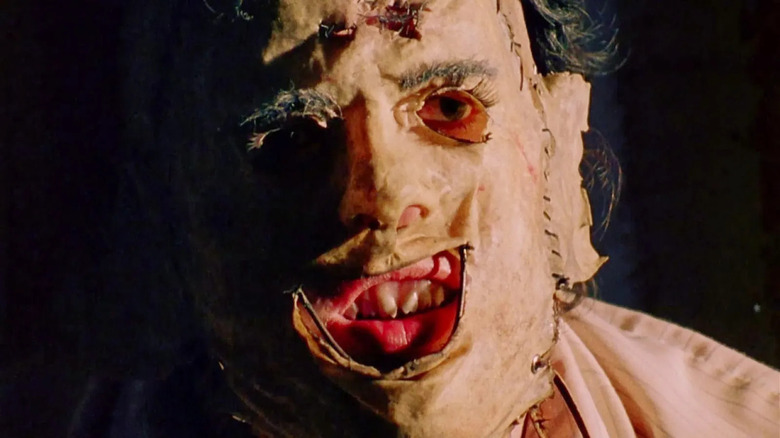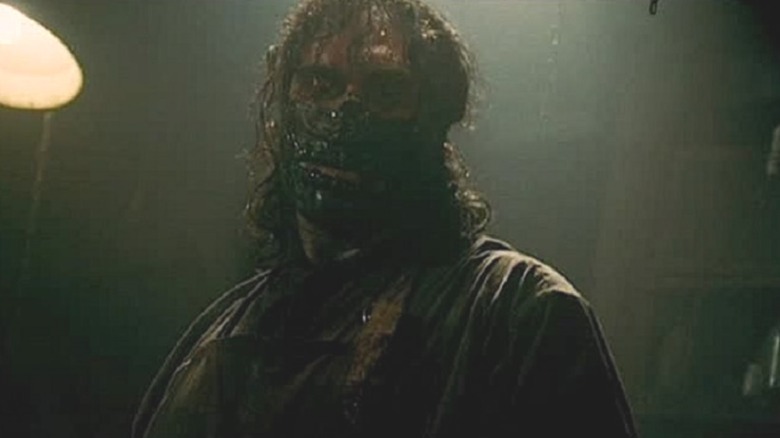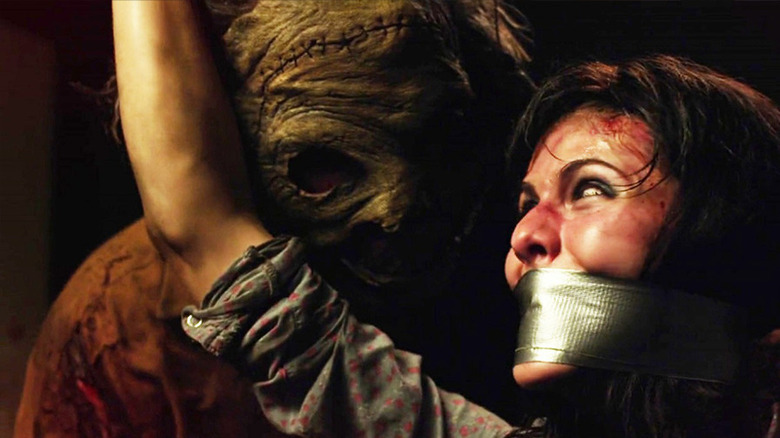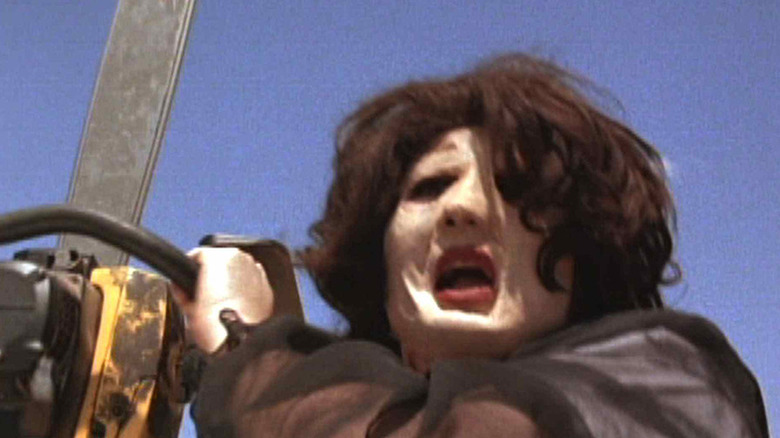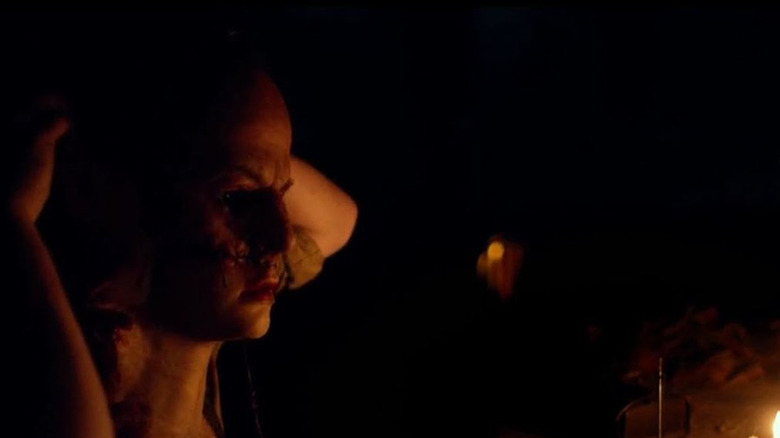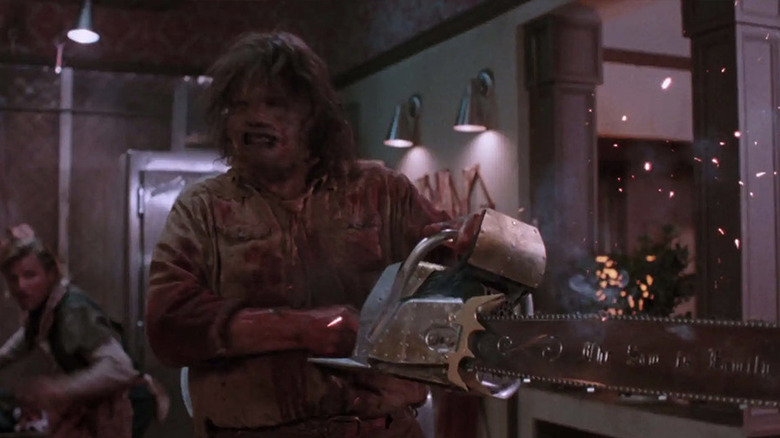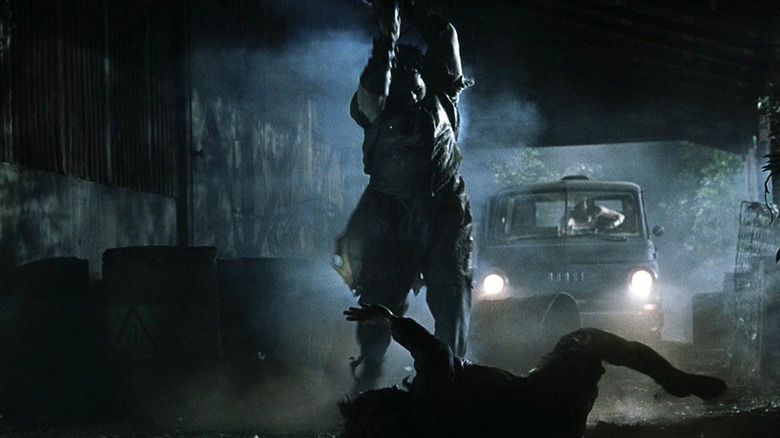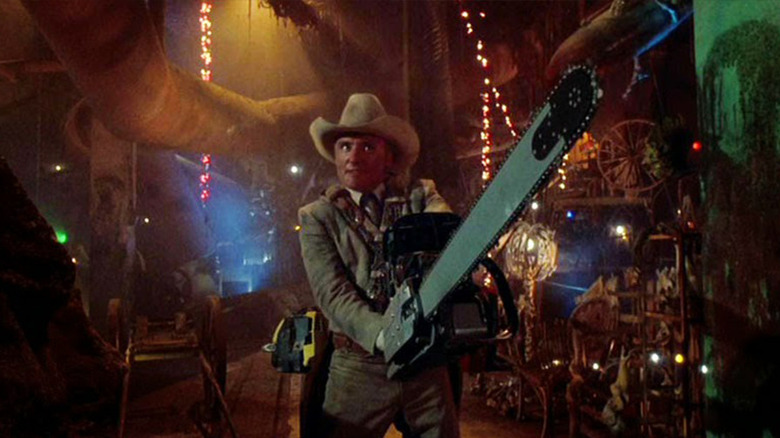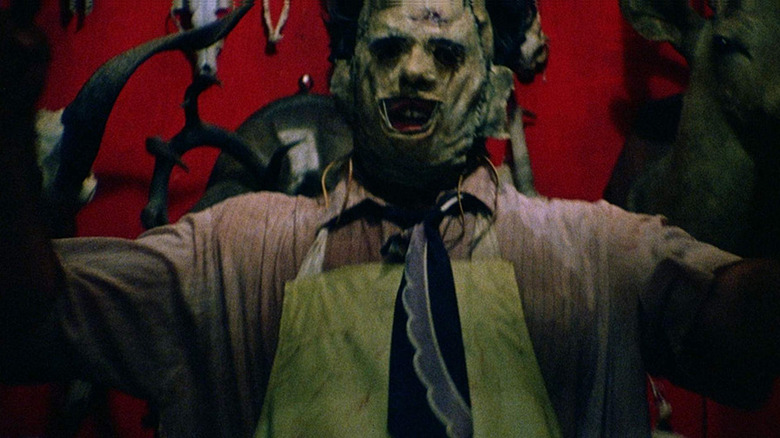All The Texas Chainsaw Massacre Movies Ranked Worst To Best
In the annals of horror cinema there are very few films as celebrated as the original "The Texas Chain Saw Massacre." Directed by Tobe Hooper, the film was inspired by news coverage of Ed Gein's gruesome Milwaukee crimes in the 1950s. In many DVD interviews, Hooper has also noted that the film was heavily influenced by the state of things in the 1970s — especially the Vietnam War. What would emerge was a film originally titled "Headcheese" and even "Leatherface," but eventually known as "The Texas Chain Saw Massacre." To say the original movie was a success would be a gross understatement, as it made over 30 million dollars against its miniscule budget.
With that success, however, came sequel after sequel and reimagining after reimagining -– resulting in an eclectic franchise to say the least. With a series containing eight entries –- soon to be nine –- some are bound to be better than others and that's what we are ranking today. These are all of the "Texas Chainsaw Massacre" movies ranked from worst to best.
8. Texas Chainsaw Massacre: The Beginning
If one were to ask what's the true "bottom of the barrel" for the "Texas Chainsaw Massacre" series, this would most definitely be it. Not only is it devoid of any impressive filmmaking technique, it lacks any real reason for its existence. The film promises to fill in the gaps on Thomas Hewitt aka Leatherface's backstory, but the insight it gives is minimal at best. Leatherface is almost a non-factor in this film, with more time being given to his psychotic family. Even the returning R. Lee Ermey –- who once again gives it his all acting-wise –- can't save this gratuitous waste of celluloid. Additionally, the victims are all one-note, incredibly by-the-numbers horror movie protagonists — none with any real personality to speak of.
At the time, many filmmakers and studios were looking to capitalize on the "Saw" franchise's trend of gratuitous violence and sadism. Unlike the "Saw" films however, this movie lacks any nuance, engaging characters, or memorable moments, making for a truly underwhelming watch. It's a prime example of the sad state of horror in the mid-2000s, and a film we would all be better off forgetting.
7. Texas Chainsaw 3D
The one bit of praise we can allocate for "Texas Chainsaw 3D" is its mildly improved cinematography and overall respect for the franchise. But this is still far from a movie we'd recommend even for the most hardcore "Texas Chainsaw" fans. The film attempted to cash in on the 3D craze that even by 2013 was in consistent decline. The gimmick itself does very little to elevate the film, resulting in the 2D version having several awkward shots and moments. The main cast is on the same level of memorability as "Texas Chainsaw Massacre: The Beginning," with none showcasing anything of substance. Much like the "Halloween" franchise, this entry deploys the baffling choice to make its protagonist Edith related to Leatherface.
The final moments of "Texas Chainsaw 3D" are nothing short of a cinematic embarrassment as Leatherface is turned into a kind of antihero. The once-menacing killer finds himself at the mercy of a corrupt sheriff, completing his transformation into an absolute joke. Edith throwing Leatherface his chainsaw and telling him to "do your thing cuz" is a special kind of cringeworthy. The best compliment we can bestow on this movie, as previously mentioned, is its respect for the franchise through certain cameos. Series alumni such as Bill Moseley, Gunnar Hansen, Marilyn Burns and John Dugan all return in small appearances. It's a definite treat to see them back in a "Texas Chainsaw" entry, but it's not enough to save this clunky, cringey and ultimately forgettable installment.
6. Texas Chainsaw Massacre: The Next Generation
"Texas Chainsaw Massacre: The Next Generation" is a fascinating kind of terrible — definitely the kind that requires study. This fourth entry in the series is where things really started to go off the rails in terms of tone and quality. Set in the '90s, the film follows four youths who, after their school prom, find themselves facing off with the notorious Leatherface. What makes this installment so intriguing is its very confused, often cynical tone -– with some suggesting that it parodies itself or the horror films of the '90s.
In this film, Leatherface is portrayed less as a lumbering backwoods psychopath but more as a psychotic screaming drag queen. It's also noteworthy for its cast, specifically future megastars Renée Zellweger and Matthew McConaughey doing some of their earliest onscreen work. The film was originally set for release in 1995 as "The Return of The Texas Chainsaw Massacre," but it wouldn't see release until 1997. The film is certainly ambitious — with the original film's co-writer, Kim Henkel, serving as director –- but was perhaps a bit too weird for its time. Give it a watch if you are up for something bizarre and obscure to add to your horror rotation, but otherwise stay clear.
5. Leatherface
This 2017 entry is where the series elevates from outright bad to staggeringly mediocre. In the film we meet a young Jedidiah Sawyer who –- after being adopted by the Sawyer family — is thrown into a mental hospital. Following a violent incident, he and several other patients, with one nurse in tow, go on the run from the vengeful Sheriff Hartman (Stephen Dorff). This impromptu road trip results in one of the escapees becoming the notorious Leatherface. The film is not without merit, and is held aloft by standout performances from Dorff as the sheriff and Lili Taylor as Jed's adopted mother Verna. Both bring a level of effort and dedication to their respective roles that is leaps and bounds ahead of many standard straight-to-home-video performances.
Sadly, where this film falls flat is in its portrayal of Leatherface, whose backstory is made needlessly complicated. The film implies that it's going to be one of the more deranged escapees, Bud, who dons the mask, when it actually turns out to be Jackson (Sam Strike) aka the real Jed Sawyer. This twist comes right out of nowhere, leaving the audience confused as to how this scrawny, moderately normal teenager could ever become the monstrous Leatherface. In its closing moments, "Leatherface" boasts some moderately disturbing visuals and music, but proves to be too little too late. We commend the filmmakers for their unique take, but perhaps Leatherface is a character who benefits from anonymity and mystery.
4. Leatherface: The Texas Chainsaw Massacre III
In the 1990s, New Line Cinema acquired the rights to the "Texas Chainsaw Massacre" franchise, which would result in a brand new film. New Line Cinema had built itself with the "Nightmare on Elm Street" series and its main antagonist, Freddy Krueger. Snatching up another viable horror icon for another series of movies seemed to be a no-brainer — unfortunately, so is this entry. The film lacks the grittiness of the original film or the camp of the sequel, leaving it scrambling for an identity of its own. It's not surprising the film feels so slapdash, as it took 11 recuts and four minutes of deleted footage to acquire an R rating. Because of this the film has very little in the way of impressive gore effects and very little in terms of substance storywise.
The film is not without quality elements however, as R. A. Mihailoff plays a great Leatherface — equal parts menacing with some moments of dark humor mixed in. Additionally, we see a young Viggo Mortensen, who succeeds at playing a genuinely entertaining psychopath as Edward "Tex" Sawyer. Not to be forgotten is Benny, played by the incomparable Ken Foree — best known for "Dawn of the Dead." While not as scary or memorable as its predecessors, "Leatherface: The Texas Chainsaw Massacre III" succeeds at being a moderately serviceable horror film.
3. The Texas Chainsaw Massacre (2003)
From classic slashers to old ghost movies, nothing was seemingly off-limits in the 2000s for Hollywood to resurrect and make a profit from. One addition to this trend that was, and still is, a considerable cut above the rest (pun very much intended) is the 2003 remake, "The Texas Chainsaw Massacre." The film, much like the original, follows a group of partying youths en route to a Lynyrd Skynyrd concert in Dallas. This excursion unfortunately places them in the crosshairs of Leatherface and his entire demented family. At the center of the film is Erin, played by Jessica Biel, who at the time was only just beginning her rise to future mainstream prominence. Rounding out the cast is R. Lee Ermey as Sheriff Hoyt, basically taking his drill sergeant character from "Full Metal Jacket" and cranking it up to 11.
Directed by then-newcomer Marcus Nispel, the film is a solid reimagining of the 1974 classic, especially in the case of its visuals. Whereas the original was very minimalist with its onscreen killings, due to its low budget, here the killings are raw and unrelenting. Cinematographer Daniel Pearl succeeds at imbuing the film with its own signature flair and a very effective atmosphere. His visual style makes you feel like you are going through a conveyor belt at a slaughterhouse, disgusted and utterly helpless. It might not match the original in terms of critical response, but it's definitely carved out a unique legacy of its own.
2. The Texas Chainsaw Massacre 2
Some sequels go bigger. Some sequels get dumber. "The Texas Chainsaw Massacre 2" proceeds to do both of these things with ample gusto, which results in an insane cinematic experience. This follow-up's inherent goofiness should be instantly telegraphed by its signature poster, which lovingly recreates "The Breakfast Club." This sequel –- once again under the direction of Tobe Hooper -– opts to lean into the dark humor that was present in the first film. This results in a movie that doesn't take itself seriously in any way, shape or form, resulting in rampant buffoonery. This is made abundantly clear when, in the very first scenes, Leatherface commits his first chainsaw kill while riding on the back of a truck. Audio of this murder is captured during the radio show of DJ Vanita "Stretch" Brock (Caroline Williams), which puts her in the crosshairs of the Sawyer family.
Replacing the deceased hitchhiker from the first film is the demented Choptop, played by Bill Moseley, who surpasses his predecessor's crazy with ample gusto. Not to be forgotten is the great Dennis Hopper as Lt. Boude "Lefty" Enright, who goes after the Sawyers armed with his own chainsaw. Many of the "Texas Chainsaw Massacre" films try to imitate the original's gritty nature, often to very mixed results in terms of quality. This entry opts to just embrace its complete absurdity, which results in a cheesy but supremely entertaining film.
1. The Texas Chain Saw Massacre (1974)
Was there ever any doubt that the original "The Texas Chain Saw Massacre" would be ranked as the best entry in the series? It's a film that, nearly 50 years after its release, still stands out as a truly disturbing and hauntingly realistic horror film. The film purports itself to be "based on true events," which is a half truth, as the film was loosely inspired by the crimes of Ed Gein. We meet a group of five youths on a road trip that takes them through a very remote and rural area of Texas. After a gruesome encounter with a deranged hitchhiker, their trip quickly becomes an unrelenting nightmare as they encounter Leatherface. Very soon all but one of the youths, Sally Hardesty, are horribly butchered and dismembered, leaving Sally at the mercy of Leatherface and his psychotic family. The film's finale — which kicks off with one of cinema's most disturbing dinner scenes — results in one of horror's most thrilling, intense chases.
From its terrifying sound design to its disturbing visuals to its aged film stock appearance, "The Texas Chain Saw Massacre" just oozes an aura of disgust and unease. Director Tobe Hooper was very vocal in later years about the film's nightmarish production, which was heavily hindered by its low budget and the unrelenting rural heat. The true terror of "The Texas Chain Saw Massacre" is that, even though it's fiction, it showcases a certain amount of haunting realism that few horror films have ever matched.
